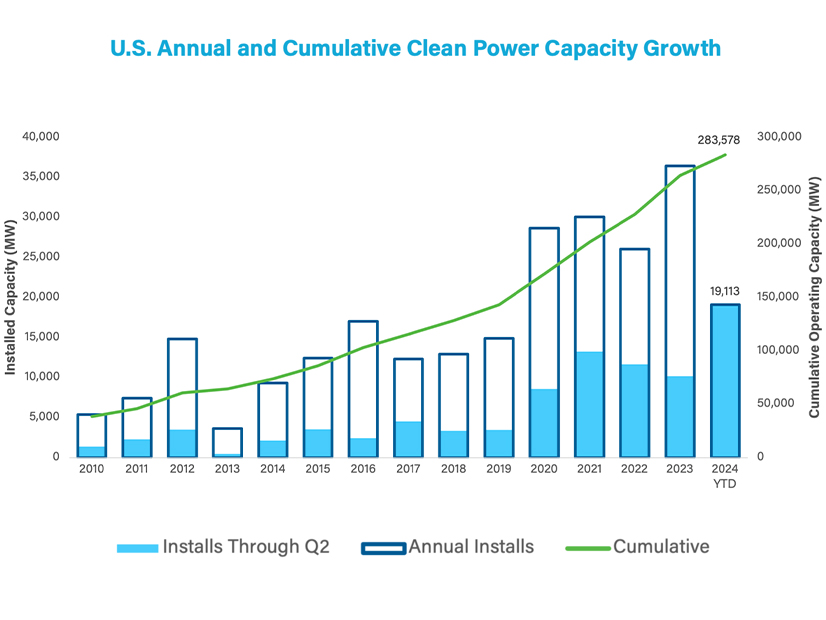
American Clean Power Association on Sept. 5 released its latest Clean Power Quarterly Market Report, in which developers set a record for the second quarter with 11 GW of installations — up 91% from the same period last year.
In all, 137 utility-scale projects went online, and they brought the cumulative nameplate capacity up to 283.6 GW across utility-scale solar, storage and wind — enough to power 70 million homes.
The second quarter brought installations up to 19 GW across the first half of the year. ACP noted the second half usually sees higher installations, so 2024 could set a record for solar, storage and wind installations. The first half of the year beat the previous five-year average by more than 10 GW.
“While all clean energy technologies are expanding their market share, energy storage is scaling at a stunning speed and has surpassed 20 GW of operating capacity,” ACP CEO Jason Grumet said in a statement. “With rapidly growing demand and the need to make significant strides in decarbonizing our economy, the stakes are high. Our recent progress is encouraging, but we are not moving fast enough.”
The quarter saw California lose its crown as leading state for utility-scale solar, as Texas added 1,656 MW — bringing its total installations to a whopping 21,932 MW. Across the country, solar saw 6.7 GW installed, or 61% of overall clean energy installations.
Storage added 2.9 GW around the country in the second quarter, which brings its total installations to 21.6 GW.
Land-based wind saw the smallest installations among the three technologies, with 1,370 MW installed in the second quarter. But that was more than triple the capacity added in the first quarter.
Onshore wind still represents most of the installed capacity for renewables in the country, but solar is closing the gap — at 39% at the end of the second quarter, up from 26% on Jan. 1, 2020.
Some 32 states and the District of Columbia added clean energy capacity in the quarter, with Texas leading the way with 2,596 MW overall. California came in second, adding 1,947 MW. Of that, nearly 70% was storage, a trend that should continue because storage represents 64% of the clean capacity in the Golden State’s development pipeline.
The clean power pipeline of projects under development is at nearly 163 GW, which is up 13% from the middle of 2023 and has been growing at 5% annually. The steady expansion of the pipeline can be attributed to storage and solar, which have grown at average rates of 12% and 3% per quarter since 2022.
The pipeline dipped 1.5% from the first quarter due to projects entering operation and the cancellation of New York’s third offshore wind project. The decline should be short lived, with an additional 8 GW to 12 GW of offshore wind set to be added to the pipeline as states wrap up ongoing procurements.
ACP Welcomes the 10th BOEM Offshore Wind Approval
The report was released a few hours before the Bureau of Ocean Energy Management approved the country’s 10th offshore wind project — the Maryland Offshore Wind Project, which brought total approvals by the agency to 15 GW.
“Today’s approval of our nation’s 10th offshore wind project — a total game change from the zero projects approved before President Biden and Vice President Harris took office — shows the tremendous progress we are making to harness this economic opportunity that [benefits both] American workers and the planet alike,” White House National Climate Advisor Ali Zaidi said in a statement. “From port infrastructure upgrades and new tax credits to speeding responsible and efficient permitting, we are using every tool available to continue turbocharging this industry and delivering a clean energy future for the nation.”
The Maryland project is planned to add 2 GW of offshore wind capacity and would supply power to the Delmarva Peninsula. Its lease area is 8.7 nautical miles offshore Maryland and about 9 nautical miles from Sussex County, Delaware.
“In just four years, the U.S. went from zero permitted offshore wind power projects to 10, representing real progress,” ACP Vice President for Offshore Wind Anne Reynolds said in a statement. “Of these, one project is completed and five are under active construction.”



